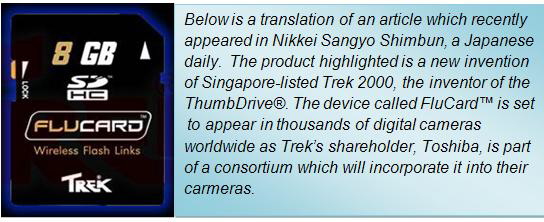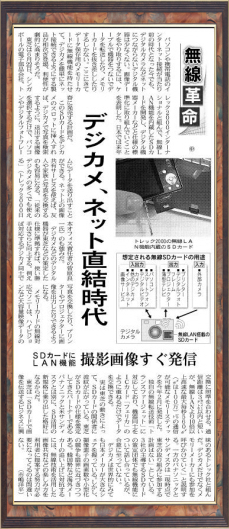
WHILE THE Internet connection of personal computers and mobile phones are taken for granted, there are still some digital devices, like digital cameras, which are still not connected to the Internet. To transfer picture data out of a digital camera, we either use cable or simply pull out the memory card from the camera and insert it into our computer.
 Lately, we note the announcement of memory cards with built-in wireless communication function that allows digital cameras to connect to the Web easily.
Lately, we note the announcement of memory cards with built-in wireless communication function that allows digital cameras to connect to the Web easily.
On 22 June, Toshiba, partnering a Singapore electronic device company, Trek 2000 International, announced the development of a SD card with built-in wireless LAN function, and it is working toward standardizing the specification among digital device manufacturers.
The product will be shipped next spring. When the new “SD Card” is inserted into a digital camera, it can transmit pictures to computers as well as digital photo frames. With the photo sharing service offered by the portal, it is easy to share photos with family members or friends.
“The card is usable by the majority of existing digital cameras,” said Mr Ryoichi Sugahara, person in charge of Japan office of Trek 2000.
If the digital devices comply to the specifications decided by Toshiba, the usability is enhanced.
For example, compatible digital cameras are able to exchange photos, and output to printers and projectors becomes possible.In February this year, Sony shipped a memory stick that is capable of 560 Mbit/sec transfer speed within 3cm.
The product caters to high volume of data transfer. The product uses a proprietary technology called “transfer jet”.
Toshiba has raised the eyebrows of SD card players.
Toshiba has taken action to define the new specifications for SD application, without involving SD Card specification partners Panasonic and Sandisk.
Toshiba explained that it is teaming up with Trek whose card is capable of transferring pictures. Beside digital camera manufacturers, Toshiba is inviting the participation of other memory manufacturers.
On the other hand, Panasonic and Sandisk said they have no plan to join the movement of Toshiba. It appeared that the three companies did not reach an agreement regarding the SD Card Consortium. Japan has a substantial share of the digital camera market.
However, the competition in the area of pixels and miniaturization has reached a limit. To counter the competition from Korean and other overseas manufacturers, it has become necessary for the Japanese manufacturers to propose new applications using wireless technologies, such as that of Trek 2000.
For Trek 2000's press release on its FluCard, click here.

 Lately, we note the announcement of memory cards with built-in wireless communication function that allows digital cameras to connect to the Web easily.
Lately, we note the announcement of memory cards with built-in wireless communication function that allows digital cameras to connect to the Web easily.  NextInsight
a hub for serious investors
NextInsight
a hub for serious investors





